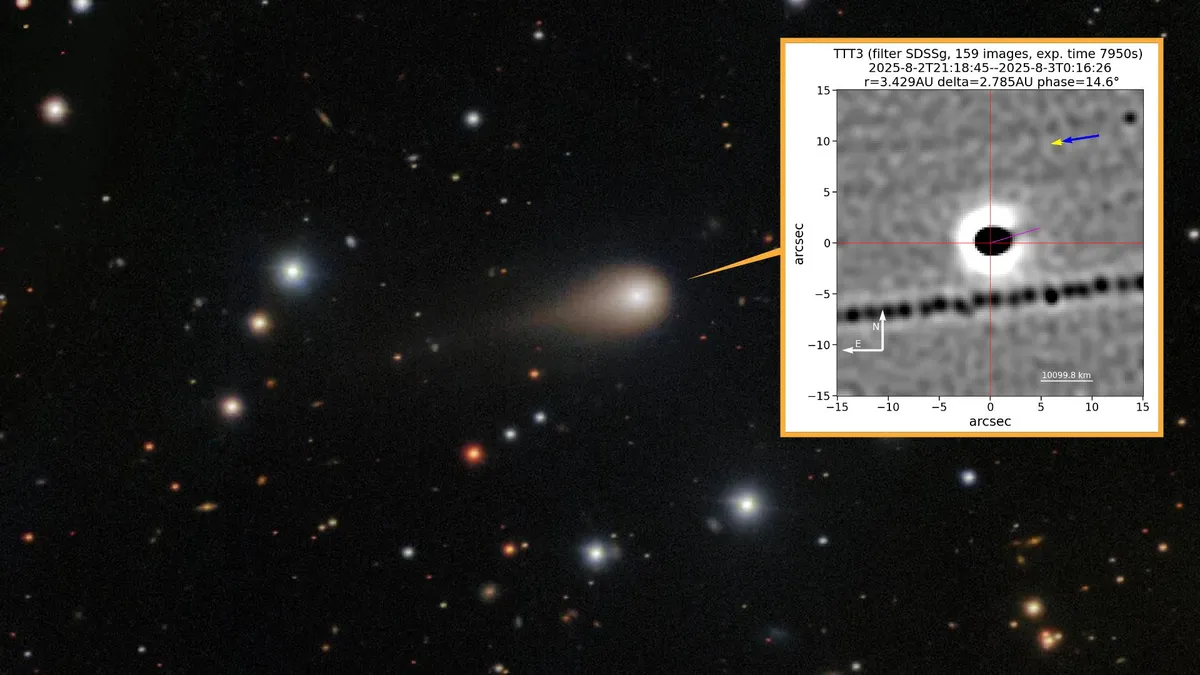
Recently released images of the interstellar comet 3I/ATLAS exhibit an astonishing phenomenon: the comet appears to be ejecting a massive jet of gas and dust aimed toward the sun. This behavior aligns perfectly with typical cometary activity. Discovered in late June and confirmed by NASA in early July, 3I/ATLAS originates from a distant star system, far beyond our solar system.
3I/ATLAS holds the distinction of being the third interstellar object ever detected. Measuring between 3 and 7 miles (5 to 11 kilometers) wide, it is the largest interstellar object to intersect our path. Scientists suggest that it may also be the oldest, potentially dating back billions of years, long before the formation of the sun. These intriguing characteristics have led a small faction of researchers to controversially speculate that the object could be an alien spacecraft sent to observe Earth. However, the overwhelming consensus among scientists is that 3I/ATLAS is simply a high-speed comet exhibiting expected behavior.
The latest images of this interstellar traveler were captured on August 2 by the Two-meter Twin Telescope (TTT) at the Teide Observatory, located in Spain's Canary Islands. The composite image, which combines 159 exposures of 50 seconds each, reveals the icy nucleus of 3I/ATLAS as a dark dot surrounded by a glowing halo. A distinctive fan-shaped break in this halo indicates the presence of a significant jet of material, highlighted in purple, being released from the comet toward the sun.
These images were shared on the transient object monitoring platform, The Astronomer's Telegram, on October 15, but have not yet undergone peer review. Comets are well-known for their luminous tails composed of ionized gas, which can extend for hundreds of millions of miles in the opposite direction of the sun. In contrast, comet jets are significantly smaller and can actually point towards the sun. According to Miquel Serra-Ricart, an astrophysicist and chief science officer at the Teide Observatory's Light Bridges research institution, this behavior is entirely normal for comets.
Serra-Ricart explained, “Jets are pointing to the sunward direction, while the comet's tail extends in the anti-solar direction.” As comets approach the sun, they heat up, but this heating is not uniformly distributed. The side of the comet facing the sun experiences the most rapid heating, and if a weak spot on its surface becomes sufficiently warm, sublimated gases can escape like a geyser, propelling cometary materials thousands of miles toward the sun. The rotation of the comet causes the jet to take on a fan shape, similar to what is observed in the new TTT images.
The famous naked-eye comet NEOWISE, which passed close to the sun in 2020, also exhibited fan-like jets as observed by the Hubble Space Telescope. Some material from these jets contributes to the comet's coma—the glowing cloud of material surrounding the nucleus—while additional particles may be pushed into the comet's tail due to radiation pressure from solar wind. This phenomenon allows comets to display both sun-facing jets and anti-sunward tails simultaneously, without the need for any extraterrestrial technology.
Although the exact distance that the newly identified jet extends remains uncertain, Serra-Ricart estimates it could reach approximately 6,200 miles (10,000 kilometers) from the surface of 3I/ATLAS. The composition of this jet is likely to be primarily dust particles and carbon dioxide, which aligns with the findings of the large gaseous plume detected by the James Webb Space Telescope in August.
In summary, the interstellar comet 3I/ATLAS provides a fascinating glimpse into the dynamic behavior of comets, reinforcing the notion that these celestial bodies are natural phenomena with no need for sensational speculation about alien involvement.